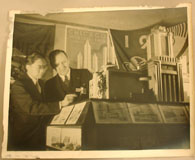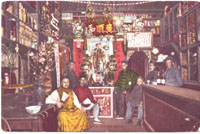AYPE China
This page is reached through the main AYP page. It offers more thorough coverage of certain Chinese-related topics discussed on that page but is really an annex. Most articles on Chinese-Americans and the AYPE will be found on the main AYPE page. To see that, click here
Genetics and world fairs: Reverend Fung Chak and family
冯察牧师家族与万国博览会结缘
After lunch on China Day (Sept 13, 1909) in the Alaska-Yukon-Pacific Exposition Auditorium, Lew Kay, a recent graduate of the University of Washington, made his opening remarks as chairman of the proceedings. When he had finished, according to the Seattle's Post-Intelligencer,
Paul Fung's famous PI cartoon. The Salvation Army had a more warlike image in those days
Silas Fung shows off his World Fair collection in Chicago, 1940s
1. Genetics and world fairs: Reverend Fung Chak and family 冯察牧师与万国博览会
3. The Dragon at the AYP Exposition 西雅图博览会: 舞龙
The P-I may not have known that Reverend Fung had come from China specifically as a missionary to Chinese Americans. Notable as the first Chinese in the U.S. to be ordained in the Baptist Church, he had translated many hymns into Chinese and traveled repeatedly between China and the West Coast to serve as a minister to Chinese communities. Between 1873 and 1910 he made five such trips. His sons all were born in the United States.
The P-I certainly did not know that Fung’s descendants would have subsequent connections with other world fairs and with the P-I itself. One of the two sons who sang so prettily on China Day, 11 year-old Paul, studied art in Seattle and became a cartoonist for the Post-Intelligencer before joining King Features to help create “Blondie.” An earlier cartoon became nationally famous -- Paul Fung’s “The Sweetheart of the Allies,” shown here, was first published in the P-I in 1915.
One of Reverend Fung’s granddaughters would marry a son of Hong Sling, 汤信, the manager of the Chinese Theater and Joss House exhibit at Chicago’s World’s Columbian Exposition of 1893. Another of Reverend Fung’s sons, Silas Fung, 冯斯立, would become the nation’s top collector of memorabilia from Chicago’s next world fair, the Century of Progress Exposition of 1933-4. The Fung Collection is now housed in the Museum of Science and Industry, Chicago.
The Chinese community gives Taft a more modest gift
On September 26 2009, the Seattle Times (pt. 3, p 17) ran a short article with the headline "President Taft to Get Embroidered Portraits" and the subhead "Chinese Village Management to Present Executive with Works of Silken Art."
The article went on to describe the embroideries as portraits of President Taft and his wife Helen, created by "children under 12 in southern China" and exhibited in the Chinese Village until selected as a presidential gift. They were to be presented by Ah King, the manager of the Chinese Village, who told the Times that Taft would receive the gift because "the chief executive is known to have a very friendly feeling toweard the Chinese people."
Taft did indeed have a friendly feeling toward China and the Chinese. He had traveled in China, had extensive contact with Chinese Filipinos during his time as governor-general of the Philippines between 1900 and 1904, and spoken out against the Chinese Exclusion Laws while serving as Secretary of War in 1905 (New York Times, 6/16/1905). He probably did accept the embroidered portraits while touring the AYPE and may even have kept them, though by now they have disappeared.
The gift was a success from a public relations point of view. It yielded the Seattle Chinese a newspaper article with a headline and a subhead on September 26. The gift to Taft by Seattle Japanese of an engraved bronze vase seems not to have been noticed by reporters, and even the showy Japanese government gift of a very expensive cloisonne vase did not receive much more publicity than the inexpensive Chinese embroideries. Ah King and his Chinese colleagues, who did not have much money or a home country governent behind them, managed to get a lot of bang for their buck.
The Dragon at the AYPE 西雅图博览会: 舞龙
The editors presented this PowerPoint talk last month at the annual meeting of the Pacific Northwest Historians' Guild, held at the Museum of History and Industry, Seattle. As an experiment. we are offering it here in slide form. Please let us know whether you think it is more or less readable than a normal illustrated paper.
A shop in Fresno masquerades as one in Seattle
This postcard was sent from the AYPE to Saratoga Springs, New York. The sender must have bought it on the fairgrounds, where special kiosks sold Exposition postcards that included AYPE scenes printed by the E H Mitchell company of San Francisco. The one shown here had a caption (in red letters, within the picture) that identified it as "#1846 A Chinese Shop."
The postmark on the back gives the place and date of mailing: Seattle, September 5, 1909, which was the day after Japan Day at the Exposition. The writer's hastily-scribbled note reads "went out to the fair it is a nice site there is a lot of [Japanese} out here [Japanese] had a fireworks last night on the water"
The writer undubtedly felt that the postcard had something to do with the Exposition, or at least with Seattle. However, she/he would not have felt that way if they had seen another E H Mitchell postcard, which showed the same store but with a caption reading "#1844 A Chinese Shop in Fresno, California."
We cannot be sure that the omission of Fresno from the caption on the AYPE postcard was not just an oversight rather than a ploy by the Mitchell Co. to adapt one of its stock images for sale in a new market. Either way, finding that the shop was in Frasno instead of Seattle is disappointing to visual historians in the Pacific Northwest, who, unlike their colleagues in California, New York, or even the Midwest, almost never see early pictures of the interiors of Chinese-American shops, institutions, or homes.
For a comprehensive listing of known Mitchell postcards, see http://www.thepostcard.com/walt/pub/ehm/chklst/ehmchk.htm
AYPE postcard showing Chinese shop, front
The same postcard, back.
版权 Copyright is free for non-profit use: : click here for more information





